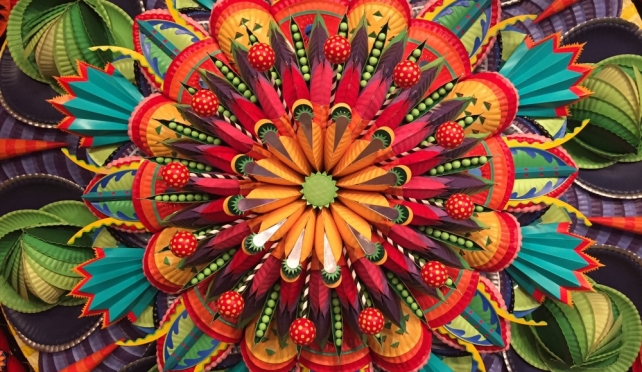In recent years, the world has witnessed an outpouring of creative advocacy and consciousness-raising in calling for the greening of food systems. The American Visionary Arts Museum’s (AVAM’s) current YUMMM! exhibition is no exception—offering a cornucopia of food-inspired art and a powerful message when it comes to realigning food systems with the laws of nature.
Among the featured works are a garden-themed mechanized mandala made of brightly colored paper plates, a wall decorated with antique lunch boxes, a giant marshmallow Peeps chef, seed paintings, and works celebrating the connection of indigenous peoples to the land.
YUMMM! delivers both a feast for the eyes and a cautionary note about current threats to human health and the earth’s carrying capacity. These include global warming, escalating obesity, bee colony collapse, the environmental cost of meat production, and plastic pollution. Peppered throughout are sobering facts about misguided agricultural systems and policies that run contrary to natural laws.
Not far from the exhibit’s entrance is a wall-mounted TV monitor with a running loop of a documentary film in which Great Kids Farm plays a starring role. The film, Cafeteria Man, produced by director Richard Chisolm and me in 2011, chronicles the early days of Baltimore’s school food reform movement. Its presence in the AVAM exhibit speaks to the power of art in nurturing social change, with the film having contributed to a broader school food dialogue across the U.S. and in parts of Europe.
The film follows then School Nutrition Services Director Tony Geraci as he strives to cook up change within a bureaucratized system, testing out new ideas to see what works in improving the quality of school food, nutrition education, hands-on learning, and culinary training opportunities. Baltimore students, too, play an invaluable role in advocating for healthy alternatives to the status quo.
The film freezes two years of the city’s school food movement in time. Now, five years later, it’s clear that while a number of those reform measures introduced persist, others do not. On the plus side of the ledger is Great Kids Farm, which continues on as one of the most enduring legacies of this reform chapter. In the last year alone, nearly 3,000 students from 100 schools visited the farm. Many more students benefited from farm produce served in school cafeterias and from seedlings distributed for school gardens.
Youth also play a vital role in the AVAM exhibition. A Community Bread Art Wall created by high school students in Massachusetts shows how toasted bread, bagels, and gilded baking pans can be used to convey messages related to hunger, homelessness, and ecological sustainability.
One of my favorite displays is a wall decorated with diverse mealtime blessings. One Native American prayer reads:
We give thanks for the plants and animals
Who have given themselves
So that we can enjoy this meal together.
We also give thanks for our friends and family
Who have traveled here today.
May this meal bring us strength and health.
Thank you, AVAM, for this nourishing show and blessings on Great Kids Farm and its staff and volunteers for the creativity and hard work they invest every day in cultivating the land and raising students hungry to learn.
YUMMM! The History, Fantasy, and Future of Food exhibition runs now through September 3, 2017.
Great Kids Farm and the Art of Social Change
| Category: from the Board


